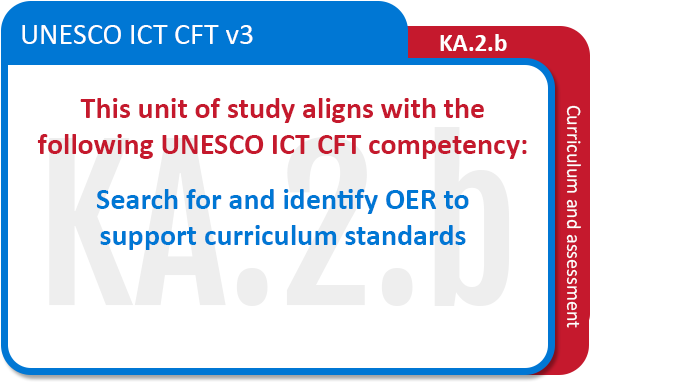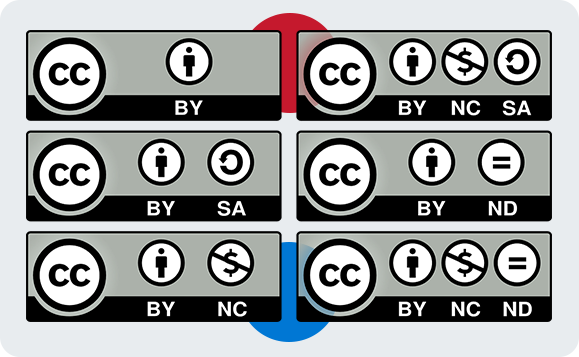Topic outline
- General
- Welcome and introduction


According to Creative Commons there are over 1.6 billion openly licensed teaching and learning resources available on the internet. Open Educational Resources (OER) are quality, free educational resources, that you can use without having to ask for permission, and that can be adapted to better suit local contexts and needs. The video below explains their potential.
The issue, however, is how to find these resources as there is no one-stop shop for open resources. Many educators and developers don't know how to efficiently search for and identity useful resources. Some throw up their hands in horror and give up when tasked with finding suitable resources on the Internet. In this tutorial, we are committed to providing you with a search strategy for open content to ensure that you quickly find open resources. Let us begin!
On completion of this unit of study you will be able to:
- Decipher open licenses i.e. identify rights and permissions contained within Creative Commons licences attached to open content.
- Search for open content using common tools and filters such as on Google Advanced Search and the YouTube Creative Commons filter, as well as specialized services such as Creative Commons Search to find open media.

- Open licensing

Consider
How do we know when a resource is 'open' and how is it different from any other educational resource? We know when educational content is 'open' because these resources display an open licence. Open licences reserve specific rights and relax others making it easier for educators and course designers to use the resources. Can you decipher the six Creative Commons licences below?

A basic knowledge of the specific rights open licences reserve (or not) is important if we want to access, copy or adapt open content. Access the tutorial below to investigate further.
Additional resourcesConsider these resources for enrichment:
Where to look for open contentOnce you are comfortable with what each of the Creative Commons licences mean, the next step is to go out and find the resources that have these licenses. Sadly, there is no one-stop shop where you might go to search for, and collect, open content. We need to use various search techniques in order to source the open educational resources (OER) that carry the Creative Commons (CC) licenses.
- Open content search techniques

Search for OER
The internet is a vast 'space' and its not always easy to navigate or to find specific resources, so how do you find open educational resources (OER)? Access the tutorial below to investigate how to do this.
Support resourcesThe links below are used in the tutorial and are posted here for easy access and reference.
- Adapt open content

Consider
It is rare that a search for open content reveals resources perfect in every way for a new learning context. It is possible that the language style is not suitable for your students. Perhaps a full translation into another language is necessary! Images that accompany a resource might need to be replaced with familiar local examples. It is also possible that not the entire resource is appropriate and needs to be shortened or supplemented with additional information or activities. However OER do allow repurposing or adaptations. Access the tutorial below to investigate how to do this.
Support resourcesThe links below are used in the tutorial and are posted here for easy access and reference.
- Open content assignment

Do it for real
- Identify curriculum parameters: We want you to create a list of OER and OCW that could be used in your teaching subject. Before you start searching, review and identify a segment from the curriculum that would benefit from additional resources and multimedia.
- Create an 'attribution list' template. In MS Word, or any other word processor, create a template where you can store the open content you will discover. We would suggest you use a format like the one here:
- Author's surname, Initial. (year). Resource title. Web location with link. Creative Commons licence.
- Identify at least one video OER: Use the skills and tips included in this learning pathway to search for and identify at least one openly licensed video that can supplement your teaching course. Include the details, a live hyperlink to the video, and the CC licence in your attribution template created in step 2 above.
- Identify at least one graphic, chart, image, or photo OER: Use the skills and tips included in this learning pathway to search for and identify at least one openly licensed image or graphic that can supplement your teaching course. Include the details, a live hyperlink to the image, and the CC licence in your attribution template.
- Identify at least one open text resource: Include this resource in your reporting template following the same format as the other resources listed above.
- Upload your completed open resource list using the assignment submission tool below.
- Conclusion, attribution and licence


Remember to apply a search protocol that provides a series of steps, or a process, to ensure your searches are effective:
- Have a clear idea of what you are looking for.
- Know your CC licenses and what they permit:

- Use Google Advanced Search Usage Rights to identify potential open content aligned to a subject or topic.
- Use Creative Commons Search to identify specific media types.
- Use the filters on popular platforms, like YouTube and Flickr, to identify open content.
- Those resources with a license that omits ND can be revised and/or remixed.

The following OER were adapted extensively in the creation of this unit of study
- Depart. Higher Education - RSA. (2019). Open Learning Approaches in South African TVET and CET Colleges. Available online at http://lms.nba.co.za/course/view.php?id=81. (CC BY)
- OER Africa. (2020). Find Open Content. Available online at https://www.oerafrica.org/communication/find-open-content/index.html#/. (CC BY-SA).
- OER Africa. (2020). Adapt Open Content. Available online at https://www.oerafrica.org/communication/adapt-new-content/#/. (CC BY-SA).
- Depart. Higher Education - RSA. (2019). Open Learning Approaches in South African TVET and CET Colleges. Available online at http://lms.nba.co.za/course/view.php?id=81. (CC BY)

ICT Essentials for Teachers by UNESCO is licensed under a Creative Commons Attribution-ShareAlike 4.0 International License.
All content not licensed under a Creative Commons licence is all rights reserved, and you must request permission from the copyright owner to use this material.
1
2
3
4
5
6
